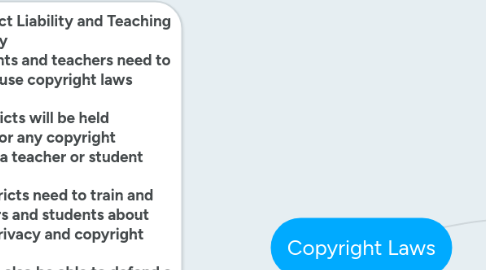Copyright Laws
by Haley Pickett

1. Part IV: Fair Use of New Technologies *If teachers and students follow the copyright laws and agreements, they can avoid any problems or future problems that may arise because of copyright material.
1.1. Guidelines for multimedia projects: The material can be used for face-to-face teaching for the students, in a job interview, reviewing a topic, and after two years the educators will need to ask permission to use the copyrighted items. For both the student and the educator, they need to cite the source from which they gathered the information.
1.2. Software on the Web: Try as hard as you can to link the software to a printed source. If you could use the printed source, then you can use the online version. You can't use the whole thing though. When you buy a license for something, you don't own it, your just renting it for a bit.
1.3. CONFU Guidelines: There was a conference to talk about new fair use rules for the new technology that was out or that was coming out. Lots of people, such as copyright owners and educators/librarians, got together to talk about the new guidelines but they couldn't agree on the CONFU guidelines because both thought it was unfair in different ways.
2. Part V: District Liability and Teaching Responsibility *Both students and teachers need to learn how to use copyright laws responsibly. *School districts will be held responsible for any copyright mistake that a teacher or student makes. *School districts need to train and warn teachers and students about invasion of privacy and copyright laws. *They should also be able to defend a teacher or student if they needed too.
3. Part I: Copyrights and Copying Wrongs *If it is an original, tangible idea, it is automatically copyrighted from the beginning. *Works in the public domain are not under copyright laws. *If you're not sure about whether something is copyrighted, ask permission!
4. Part II: Fair Use Laws *The Fair Use Laws is to allow others to use copyrighted materials as long as it doesn't stop the creator from making money. *When copying something you need to see if it is fair by paying attention to how many copies you are making, how much of the item you are copying, and if it will make the creator lose any money. *Use the public domain items as much as possible.
4.1. Guidlines for Educators: Teachers can use materials for their classroom, but they need to make sure it isn't a large portion of that material. Such as, they can copy a couple of pages from a story book, make a copy of a picture or a graph, or copy a chapter from a textbook. This is considered fair and okay for teachers to use in their classrooms.
4.2. Music, TV, Videotapes: A single copy of sheet music can be made if it is an emergency that it is needed for, also only one sound recording can be used in the classroom (like using it to discuss it as a class), and video taped recordings can be used as long as the video hasn't been altered at all in any way.
5. Part III: Copyright Laws and New Technology *You should always carefully read the licensing agreement that you see for each software that you use.
5.1. Web Resources You Can and Cannot Use: To tell if something is copyrighted you should try to link it to a printed version or source. This will help you know if it is copyrighted or part of the public domain. Always get permission to use a copyrighted source from the owner of that source, not another person who has also used that source.
5.2. Software: Once a software is created it is automatically copyrighted just like any other original, tangible creation. There are three types of software: 1) Commercial software, 2) Shareware software, and 3) Freeware. The first two soft wares you should get the permission of the author, but the freeware can be used without permission to create something new from it as long as it is still freeware afterward.


